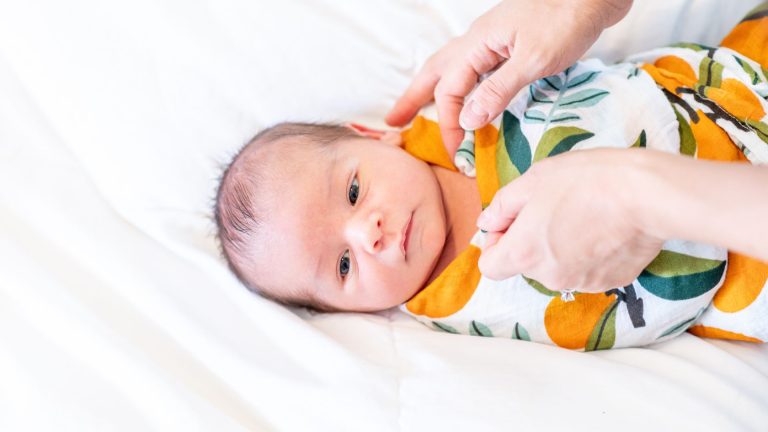
Swaddle Safety Alert: What to Do When Your Newborn Rolls to the Side in Swaddle
- Created:
3. 11. 2023 - Updated:
30. 10. 2023
Fact:
Bundling your little one in a snug swaddle is a time-tested technique for ensuring a good night’s sleep.
However:
When your newborn starts to roll to the side in a swaddle, it may raise questions and concerns.
Whether you’re a new parent or not, knowing how to respond when your baby starts rolling in a swaddle is crucial for their well-being.
Fortunately:
In this article, we’ll explore the reasons, potential risks, and the steps you need to take to ensure your baby’s safety.
Let’s get to it!

Why Some Newborns Roll to the Side in a Swaddle
Get this:
Swaddling is commonly used to provide newborns with comfort and security throughout their first few months.
According to Safe Sleep Academy, this technique is useful for babies who fuss and cry when it’s time to sleep. Also, swaddling prevents babies from rolling to their sides.
Interestingly:
Some babies still roll to their sides when swaddled, which can be a concern at a young age.
But why does this occur?
Let’s find out.
Reflex Movements
Frankly:
Newborns are born with a range of reflex movements hardwired into their nervous systems. The most common is the Moro reflex, also known as the startle reflex.
This reflex is often triggered by loud noises or a sudden change in your baby’s position. The Moro reflex causes newborns to instinctively extend their arms and legs outward in a starfish-like position.
Now:
Swaddling restricts these movements, although a swaddled baby may mistakenly roll to the side while attempting to execute the reflex.
Additionally:
Other newborn reflexes can also contribute to swaddled babies rolling to the side. The asymmetric tonic neck reflex prompts a baby to turn their head to one side while extending the arm and leg on that side.
Note:
Understanding the Moro reflex and other newborn reflexes can provide insights into why some babies roll to the side in a swaddle. This enables parents to provide the necessary support and minimize potential discomfort for their swaddled babies.
Comfort Seeking
Despite their young age, babies have distinct preferences for comfort. They move toward positions that make them feel at ease, much like adults.
So:
When swaddled, the constraints on their arms and legs influence their sleep position. The snugness of swaddles mimics the sensation of being held or cradled, which many babies find soothing.
Hence:
This sense of security can be particularly calming, making it easier for babies to fall asleep and stay asleep.
But:
Some infants find side-lying positions to be more comfortable and secure. This enables them to experience a more natural and comfortable body alignment, similar to how they were in the womb.
Note that:
These comfort-seeking behaviors vary from one child to another. Each baby has their unique preferences, and what feels most comfortable for one might not be the same for another.
Consequently:
Parents and caregivers should pay attention to their baby’s cues and adapt swaddling practices that accommodate their individual needs.
Developmental Milestones
Naturally:
As babies progress through their early months, they undergo various developmental changes and rolling is a significant milestone in a baby’s motor development.
It serves as one of the initial signs that your infant is gaining increasing control over their body. In fact, according to WebMD, some babies begin rolling on their side as early as four months of age.
Furthermore:
As your baby becomes more proficient at rolling, they will eventually progress to other motor skills like crawling.
While rolling is a positive sign of your baby’s development, it can present challenges when they roll while swaddled.
Why?
Swaddling is intended to restrict movement for safety and comfort. As a result, the American Academy of Pediatrics (AAP) advises that parents stop swaddling as soon as their babies show signs of rolling over to avoid suffocation.
Risks Associated With Rolling in a Swaddle
As you know:
Swaddling is a common practice among parents to get their newborn to sleep at night.
Nevertheless:
Doing it wrongly could lead to certain health hazards. According to Michigan.gov, swaddling causes suffocation or overheating, which are leading causes of Sudden Infant Deaths.
Here:
We’ll examine two critical risks associated with rolling in a swaddle. Shall we?
Suffocation Risks
Fact:
Rolling to the side or onto the tummy while swaddled can pose a significant suffocation risk to infants.
A baby’s ability to breathe is restricted when their face is pressed against a swaddle. This risk is especially serious for babies without the strength and agility to reposition themselves.
What can you do to mitigate this risk? It’s pretty straightforward.
First off:
Ensure that your swaddled baby is always placed on their back for sleep in accordance with NYC.gov’s safe sleep guidelines.
Then:
Use a swaddle that allows for hip movement and proper breathing space. This can help reduce the risk of suffocation.
That’s it!
Hip Dysplasia
Get this:
Improper swaddling techniques can impact a baby’s hip development negatively, potentially leading to a condition known as hip dysplasia.
Now:
Hip dysplasia occurs when the hip joint fails to develop properly, and it can be worsened by swaddling a newborn too tightly.
Basically:
To prevent hip dysplasia, use swaddles that allow for the natural extension and bending of your baby’s hips.
The International Hip Dysplasia Institute recommends swaddle designs that provide enough room for the baby’s hips to move freely. This allows them to be in a “frog-legged” position, which is considered optimal for hip development.
Guidelines for Safe Swaddling
Listen:
Swaddling only poses risks when you’re doing it incorrectly!
Luckily:
In this section, we will correctly address the key guidelines for safe swaddling, including expert techniques that minimize these risks.
With these guidelines, you can provide your baby with a secure and comfortable sleep environment. Additionally, you’ll be ensuring their safety and well-being as they grow.
Proper Swaddling Technique
Get this:
Swaddling should be done in a way that minimizes risks. With the aid of these short and easy tips, you should be swaddling your baby like a pro in no time.
Shall we?
- Secure, not too tight: The swaddle should be snug but not excessively tight. It should hold your baby’s arms and legs comfortably within the wrap without restricting their movement.
- Allow hip and chest movement: It’s important to leave room for your baby’s hips and chest to move. Swaddling too tightly around these areas can affect healthy hip development or restrict chest expansion.
- Expose the head and face: Your baby’s head and face should remain uncovered, ensuring that they can breathe freely. The swaddle should start just below the neck to keep the face exposed.
Monitoring Your Baby
First off:
Monitoring your child regularly is an essential aspect of newborn care.
Why’s that?
Babies cannot verbally communicate their discomfort or distress, so their well-being relies on your vigilance. Frequent checks allow you to identify and address any issues promptly.
Fortunately:
There are baby monitors with audio and video monitoring capabilities, like the Annie Baby Monitor. This makes it easy for you to check on your baby from anywhere in the house.
Ideally:
Monitoring includes various important aspects, such as ensuring the swaddle is positioned properly and is free of any potential suffocation risks.
Also:
You are to pay attention to any signs of discomfort or distress, such as restlessness or breathing difficulties.
Note that:
Temperature regulation is also crucial, as swaddled babies are at risk of overheating. According to Medical News Today, the ideal temperature for babies is around 98.6℉.
As such:
Keeping your baby’s temperature within this range is essential for their health.
When to Stop Swaddling
Fact:
You can’t swaddle your baby forever!
So, parents need to understand their baby’s cues to know when it’s time for them to stop swaddling.
But usually:
Some babies begin to signal a desire for increased mobility, and they become agitated when swaddled. Thus, watch out for significant developmental milestones like rolling or turning.
Furthermore:
It’s essential to consider the recommended age range for swaddling. According to Healthychildren.org, this could be as early as two months. At this stage, swaddling hinders their natural movements and may become counterproductive.
Alternatives to Traditional Swaddling
Now:
As babies outgrow swaddling, parents often search for alternative sleep solutions that accommodate their changing needs.
So:
We’ll delve into three key alternatives to traditional swaddling. Each option offers a unique approach to ensure your baby’s safety, comfort, and sleep as they progress through various developmental stages.
Let’s jump right in!
Wearable Blankets or Sleep Sacks
Listen:
Wearable blankets are often referred to as sleep sacks, and they are a popular alternative to traditional swaddling.
These are sleeveless, one-piece garments that typically zip up and keep the baby’s body warm without the need for a separate blanket.
The best part is:
Sleep sacks come in various sizes to accommodate different ages and are a safe and convenient way to ensure your baby stays warm during sleep.
They reduce the risk of loose bedding in the crib and promote a safer sleep environment. Sleep sacks also allow for greater freedom of movement, making them an excellent choice as your baby grows.
Swaddle Transition Products
Get this:
Swaddle transition products are designed to assist babies in transitioning out of swaddles.
These products are usually made with a swaddle-like feel but with the arms free, helping babies adjust gradually to having their arms and hands unrestricted during sleep.
Examples of swaddle transition products include sleep garments with detachable swaddle wings or wearable blankets with the option to wrap the baby’s arms.
Overall:
They provide the comfort of swaddling while allowing the baby to have more control over their movements, making the transition smoother.
Arms-Free Swaddling
As babies grow and start showing signs of movement, arms-free swaddling can be a safer option. These products help swaddle the baby’s torso while leaving their arms free.
It helps in maintaining a snug and secure feeling. It also allows your baby to have their hands and arms available for self-soothing, comfort, and mobility.
Hence:
Arms-free swaddling is particularly beneficial when you want to ensure your baby remains cozy with their increased mobility. They can freely roll over when they need to, reducing the risk of rolling while tightly swaddled.
Conclusion
In summary:
Swaddling is a common practice parents adopt to provide comfort and security to newborns during their early months.
However:
As your baby grows, they start to roll to their side while in a swaddle. The most common causes include reflex movement, comfort-seeking, and developmental milestones.
Now:
You should be aware of the potential risks associated with rolling in a swaddle, of which the most common are suffocation and hip dysplasia.
Luckily:
You can avoid them by following these simple guidelines for safe swaddling:
- Adopting proper swaddling technique.
- Monitoring your baby.
- Knowing when to stop swaddling.
As your baby progresses through their early months, it’s best to employ safe and comfortable sleep solutions tailored to their needs. As such, alternatives to traditional swaddling include wearable blankets, swaddle transition products, and arms-free swaddling.
Lastly:I trust this article has provided valuable insights into why newborns roll to the side in a swaddle. If you found this information helpful or have any suggestions, please do so in the comments section below.






